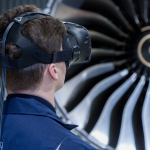Finding real value in AR needs more than real funding

Invention and technology often travel at different speeds from actual need. Sometimes digital solutions are devised to solve specific problems— the original wire telegraph that replaced slower horse-born messages, impractical on a continental basis.
On occasion, a technological breakthrough takes place but then is hardly used. The latter is most definitely the case for augmented and virtual reality. While conceptually the technology promises and arguably delivers a great deal, the physical realities involved in its practical use make it unpopular. In short, VR & AR are unwieldy, so we feel foolish, hot, or uncomfortable donning the necessary hardware or making the required physical gestures.
Despite significant investments by household name tech companies (Facebook and Oculus, Google and its Google Glass experiment), VR and AR haven’t really seized the public imagination in the consumer space. In industry, uses of the technology are gradually appearing, but are far from sweeping across multiple verticals.
Measure & draw floorplans and more with #AugmentedReality #VirtualReality #AR #MR #VR #IoT #MobileApps #smartphones #ai #ml >> via @MikeQuindazzi cc @antgrasso @KirkDBorne @andi_staub @evankirstel @GlenGilmore @DioFavatas @IIoT_World @sallyeaves pic.twitter.com/pKh6TaQW1u
— Rimah Harb (@HarbRimah) July 2, 2019
As reported in Geekwire, a company called RealWear offers a practical and seemingly useful AR deployment that is actually being used, with organizations such as China’s largest state utility State Grid signing up to buy the hardware and software, both of which are created by the US West Coast-based company.
The company’s success in signing up multiple rounds of investment is a testament to its specific yet practical uses. The AR hardware the company offers can be an extension to the type of ‘hardware’ already a legal necessity: the hard hat. The augmentations to that physical device are roughly reflected in the augmentations to the capabilities of the wearer. Workers on-site can get real-time mentoring remotely, or see practical information that provides pertinent information while work is taking place— machinery blueprints or IIoT sensor data, for example.
While a proprietary hardware and software offering, RealWear operates its own app store, where its clients can pool and share their solutions, with around 120 apps currently available.
YOU MIGHT LIKE

A dose of virtual reality for medical professionals
It’s most likely that it’s this particular aspect of the offering that will be key to the entire platform — the Apple App Store’s inception was indubitably the main driver of the original iPhone’s success. RealWear would do well to note the Cupertino giant’s experience: Apple provided reliable hardware and an easy way for third parties to share their particular uses of said hardware. The rest, as they say, is history.
Despite being a relatively new startup, the company expects next year to be “a nine-figure year,” RealWear’s CEO Andy Lowery told GeekWire.
One investor in the startup is Microsoft, a company with its finger in the VR/AR pie, with its HoloLens. Like its competitors at that scale (Google, Sony, Facebook, et al.), there’s clearly a great deal of interest combined with a high degree of random casting about; funding own and other companies’ projects, experiments, prototypes, and nascent hardware.
That’s likely to continue, but like Apple’s iOS/App Store/iPhone experiences, the likely outcome probably won’t be a “killer product”, but rather a “killer platform” — and its inevitable imitators (think Google Play Store, now even more of a cash cow than the Apple original).
As a successfully self-appointed “Geek of the Week,” last year, Lowery commented: “We are doing our part to balance what is best in people and machine, to accelerate global efficiency and bring greater global balance.” High aims, indeed.









